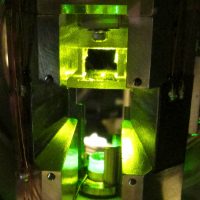News
Near Unitary Squeezing
A group at the MIT led by Prof. Vladan Vuletić has recently generated significant amount of spin squeezing-a type of quantum entanglement-in an ultracold vapor of ytterbium-171. Spin squeezed states (SSS) can be used to overcome the standard quantum limit (SQL) which bounds state-of-the-art atomic sensors like optical clocks. The latter deploy a dilute vapor of atoms to achieve matchless fractional precision in the order of 10-19. It is the first time that such an entanglement is generated in an atom suitable for an optical clock, representing thus a fundamental step towards development of quantum enhanced precision metrology.
SSS are many-body entangled states where the quantum noise is redistributed along two orthogonal directions of the spin vector in order to reduce the uncertainty in the measured quadrature. After the first demonstration of spin squeezing 10 years ago, many researchers have developed techniques to generate and control such a many body entangled state. However, SSS have been demonstrated only in atoms suitable for low performance sensors bringing , thus, no improvement to precision metrology. For example, in the field of atomic clock considerable squeezing has been achieved in rf-clocks, a system with an intrinsic sensitivity 100’000 times worse than state-of-the-art optical-clock.
Establishing any kind of quantum correlation within atomic ensembles requires a nonlinear interaction between the atoms, since they need to know about each other’s state. In the MIT experiment the ytterbium atoms are placed in an optical cavity resonant with an atomic transition and the necessary interaction is then mediated by the means of photons. In particular, the developed optical technique is beneficial for metrological applications since, on one hand, it prevents from undesirable collision and, on the other hand, the interaction can be turned off after preparation of the spin squeezed state.
Moreover, Prof. Vuletić group realized that by carefully selecting the frequency of the entangling photons the generated squeezing can be almost unitary, another requirement necessary for the future development of spin squeezed optical clock. The MIT researchers are the first to demonstrate such a squeezing property in a large ensemble of neutral atoms.
In the near future, the unitary squeezing within the magnetic sublevels of Ytterbium ground state can be mapped onto the optical transition and be used to demonstrate an optical clock operating beyond the SQL.
